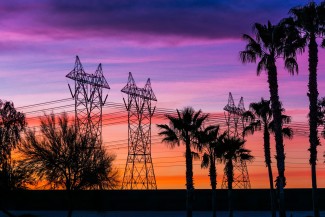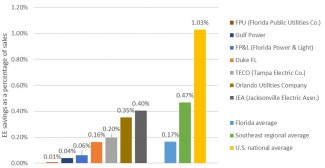Utility-led energy savings programs are essential for bringing the benefits of energy efficiency to homes and businesses, but in Florida, many are being left out. The efficiency programs there are saving a fraction of the national average, because of state rules and practices that discourage practical, high-impact investments. At a time when many Floridians are struggling to pay their bills, saving energy is essential.
A 1980 law requires the state’s seven largest electric utilities to set annual energy saving goals, but for the past several years, some have proposed goals of zero savings. This recently prompted the Florida Public Service Commission to initiate a rulemaking—which has its first workshop this week and will continue over the coming months—to amend the process for setting energy savings goals. It’s a crucial opportunity to reform utility energy efficiency policy in the Sunshine State, helping utility customers in this difficult time with programs that reduce energy bills and can lead to a better quality of life.
View ACEEE’s new white paper: Florida’s Unrealized Energy Efficiency Potential
Efficiency programs in Florida lag while many households struggle with bills
Florida’s utilities are out of standard practice in their energy efficiency program offerings, savings, and goals. ACEEE’s 2020 Utility Energy Efficiency Scorecard ranked the state’s three largest investor-owned electric utilities (Tampa Electric Company (TECO), Duke Energy Florida, and Florida Power & Light (FPL)) at 46th, 48th, and 51st out of the 52 largest utilities nationwide in terms of program performance and savings. The state’s other major utilities are similarly underperforming.
This is depriving Floridians, particularly low-income households and small businesses, of energy efficiency measures that could reduce their bills. Without targeted utility-led programs, many residents in multifamily buildings and businesses that are struggling during a recession won’t have the time, the budget, or the knowledge to access and implement energy efficiency measures on their own.
Meanwhile, many Floridians face energy bills that strain their budgets. ACEEE recently found that in the Miami-Fort Lauderdale and Tampa-St. Petersburg metropolitan areas, low-income households spend, on average, about 7% of their incomes on utility bills. And about 12% of households in these metropolitan areas are “severely burdened,” spending more than 10% of their incomes on energy costs. Black and Hispanic households are particularly likely to face high burdens.
Stronger energy efficiency programs could cut bills and create jobs
A study by the National Renewable Energy Laboratory found that the average single-family home in Florida can reduce its energy use by up to 23% through efficiency upgrades, such as improved HVAC, water heating, and lighting—an example of what utility programs can do. Most of these upgrades pay for themselves with bill savings in five years or less and can last for a decade or longer. Utility-run programs can raise customer awareness about energy saving options, reduce upfront costs of upgrades, and help customers install these technologies in homes and businesses.
In addition to providing energy savings on customers’ bills, energy efficiency is the largest source of jobs in Florida’s energy sector. Before the COVID-19 pandemic, more than 120,000 Floridians worked in the sector, performing vital work such as HVAC installation and efficient building contracting. There are more than 15,000 Florida businesses in the energy efficiency sector, and the vast majority are small businesses with fewer than 100 employees. This industry has suffered greatly during the COVID-19 recession, losing more than 18,000 jobs in 2020. Investment by utilities could create much-needed local jobs.
Energy efficiency measures also deliver system-wide benefits that reduce costs and improve reliability for everyone, even those who do not get an upgraded appliance or new insulation. Reducing the overall need for energy can delay or avoid entirely the need to construct new power plants. The overall cost of saving energy is consistently as cheap or even cheaper than most types of electricity generation, particularly fossil fuels. Investing in energy efficiency as a clean energy resource—replacing more expensive and polluting methods of generating power—can reduce electric rates for all utility customers.
The solution: Change Florida’s approach to valuing efficiency
Florida regulators have an opportunity in the new rulemaking to revamp the state’s lagging efficiency programs by reforming weak policies that are holding back progress.
First, they can eliminate the state’s reliance on an outdated cost-effectiveness test, the Ratepayer Impact Measure (RIM) test. This test overestimates costs and undervalues benefits from energy efficiency. It counts energy savings as lost revenues for the utility and considers them in addition to program costs. Under this approach, the more energy a program saves, the less cost-effective it is. Florida is the only state that still uses RIM as its primary test; every other state has moved on, recognizing that it does not accurately represent the value of energy efficiency as a resource.
Another barrier the regulators can address is the use of a two-year payback screen for efficiency measures. This blocks utilities from implementing some of the lowest-cost, highest-impact programs. For instance, LED light bulbs, which have consistently delivered energy savings in other states, are missing entirely from Florida utilities’ program offerings. This screen could simply be eliminated.
Finally, the commission can target energy savings to customers who are most in need. Although state law requires its utilities to offer some income-qualified programs, it does not include a specific spending or savings target for these groups. Establishing such requirements, either in dollars spent or energy saved, helps guide utilities’ investments and ensures they are reaching the right communities.
Implementing common-sense, outcome-based goals for customers in need and broadening utilities’ overall portfolio of offerings will help bring Florida back in step with current practices and policies for utility energy efficiency and reduce costs for households and businesses. This year is the chance for Florida to get it done.
For a detailed look at the challenges for utility energy efficiency programs in Florida and recommended solutions, see ACEEE’s new report, Florida’s Unrealized Energy Efficiency Potential. Interested in learning more? Advocates in Florida have collected resources on current and future energy efficiency policy activities.




